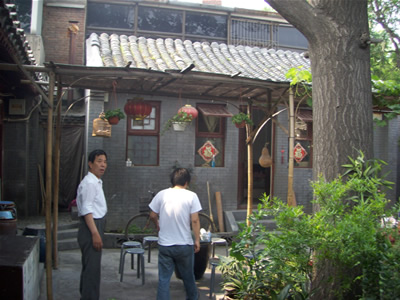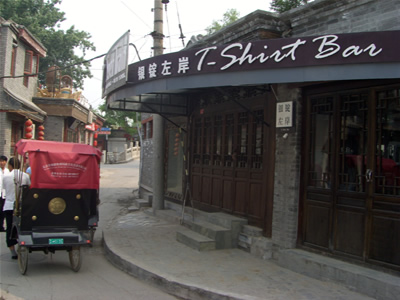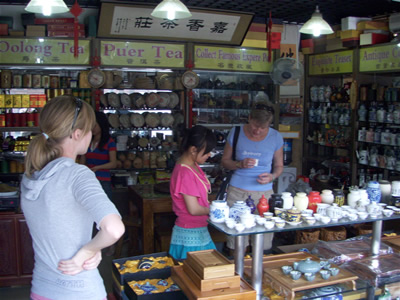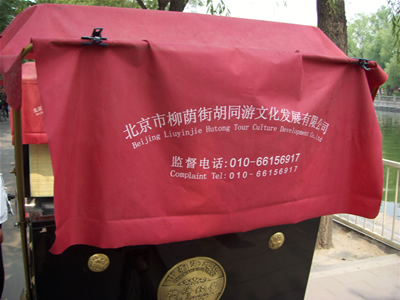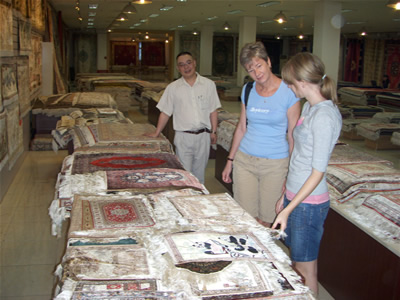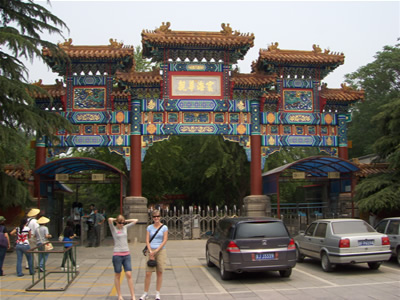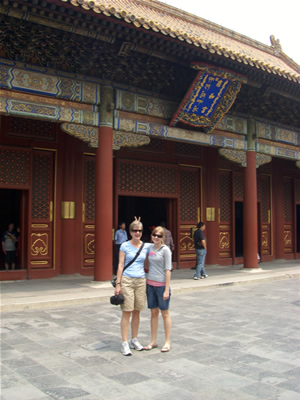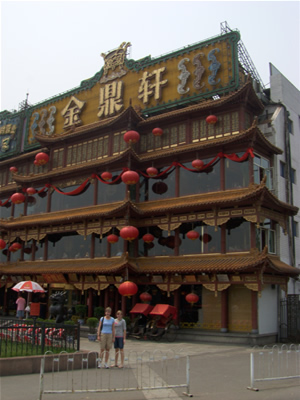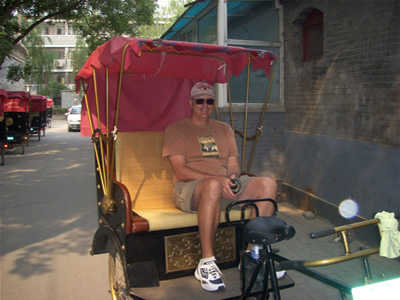China pt 5 - Bye Bye Beijing
It was our last day in Beijing and then we were moving on to Xian. The night before we got everything packed. Somehow we managed to fit all of our purchases into our luggage. After breakfast Bruce picked us up. But since our flight was in the late afternoon we still had time for some touring in the morning. Our schedule started with a tour of a local hutong and a visit to the home of some people who lived there. (I am very proud of myself. Note that the previous link does *not* just go the Wikipedia article.)
A hutong is literally an alley or narrow street. But the term usually refers to the neighborhood around the alley, especially in Beijing. These neighborhoods are walled off to separate them from the rest of the city. A central alleyway provides access into the neighborhood. The individual residences surround the alley and can only be entered from the it. The old hutongs in Beijing today are mainly found in the areas surrounding the Forbidden City. They were the neighborhoods where important officials lived during Imperial times. Although many have been destroyed since the establishment of the People's Republic as part of the modernization of Beijing, today the government is trying to preserve as many of the old neighborhoods as possible. And since they are in the heart of Beijing they are actually very expensive and prestigious to live in.
We met Michael, who was going to take us on our hutong tour. We started with a rickshaw ride. Since these are old parts of the city the streets and alleyways are very narrow. A lot of people ride in rickshaws. They are two person carriages pulled by a guy on a bicycle in the front. They are very similar to the rickshaw rides that you can get in Singapore on Victoria Street and in the Colonial District. It looked like mainly tourists were riding in them but they were fun. There was a whole line of them parked and waiting for customers. Shannon and Sandy got in one and Michael and I hopped in the other and we were off. We wound through a bunch of narrow streets and eventually stopped at the entrance to a hutong. We walked down the alleyway and entered one of the houses for a tour. Meanwhile Sandy got a call from her boss, so unfortunately she missed part of the explanation while she was on the phone. That's why they pay her the big bucks. It must have been a strange conversation. "There's a lot of background noise. Are you riding in a car?" "No, I'm riding in a rickshaw in Beijing."
From the hutong alleyway we went into a central courtyard for the household. There were a few trees and tables and it was really very pleasant. There were buildings on each of the four sides of the courtyard which totally isolated it from the city outside. Traditionally a family group would live there. The parents would live in the house on the north side. The children would live on the south side. The other two sides would be for other family members or maybe renters or even storage. We had a short discussion with the owner of the buildings, with Michael acting as translator. He explained how his father had purchased the building around the time of the Chinese Civil War. They are extremely valuable now because of their location in central Beijing. This was one reason he has opened up his house to tourists. There was a large group of about 15 Japanese tourists at the same time on a tour as well. So there were explanations being given in at least three languages in the courtyard. We also got a chance to see some of the living areas - they were small! One of the living areas was set up as a hotel room and I am sure that my feet would have hung off the end of the bed.
After the house tour it was back to the rickshaws. After another ride we stopped on a street loaded with tourist shops. A chance to go shopping! Certainly plenty of that on this trip. We did find a shop filled with tea sets. Sandy spent some time and was able to pick out a very nice set. It was packed very carefully, but now we had another large and heavy thing to carry on the plane. When she saw how big the box for the tea set was, she decided not to get the large tin of tea she had also picked out.
Then another short ride and another stop. This time Michael showed us the doorways to some of the houses and gave some of the history. It was possible to tell by the nature of the door and the decoration of the doorway a lot about the position, importance and wealth of the official who had built the house. Interesting history. Unfortunately reality intruded on the lecture. There apparently was a problem with the sewer along this street, so right behind was a truck and some guys working on it. They were clearing the sewer, or pumping it out, or something. But whatever it was created the most horrible smell imaginable. We were good soldiers and toughed it out, but I thought Shannon was going to die.
From there we walked to the Silver Ingot Bridge. This crosses a small canal that connects two lakes. There is a pretty walkway along the canal and it's lined with small bars, restaurants and shops. The area is popular with tourists and with trendy locals as well. After a quick walk around we had a last rickshaw ride back to our van.
We had one more shop/factory tour left. We visited a carpet factory. It was amazing to see how the weaving of a large carpet was actually done. The denser the weave of the carpet, the higher the quality and the higher the price. An inexpensive (relatively) carpet might have 200-400 threads per square inch, while a very high quality carpet could have 1200-2000 per square inch. A small carpet that was only two square feet but had a very dense weave might take a master carpet maker six months to make! We saw some incredibly beautiful carpets and thought about getting one, but the prices ran into the thousands of dollars. These were carpets that you would never think of putting on your floor and walking on. They were meant as wall hangings. But they were a little too pricy for us. I was of course relieved to know that we weren't adding another item to our already crammed and heavy luggage. The guy giving us the tour of the factory was excited for a while because he thought that he had a big sale but he ended up disappointed. But it wasn't a total loss for him as we found some nice silk wall hangings that we bought.
We still had time for one more stop - the Yonghe Temple. It is also known as the Lama Temple because of the number of monks who live there. It is one of the largest and most important Tibetan Buddhist temples in the world. For about two blocks around the temple the streets were lined with shops selling buddhist religious items and incense to take to the temple. The temple is organized along a north-south axis like everything else in Beijing. It is almost half a kilometer long. There are five main halls and each has a successively larger and more impressive statue of the Buddha. The last hall has a huge statue that is 26 meters tall carved from a single piece of sandalwood (that must have been a pretty big tree!). We don't have any photos from the inside of the temple buildings as we were requested not to take any photos of the Buddha images.
The temple is a mix of Chinese and Buddhist architectural styles and is quite beautiful. The inscriptions are all in four languages: Chinese, Tibetan, Manchurian, and I have no clue what the other language was. The Manchurian and Tibetan script were very similar and quite unusual. It tended to be written vertically and definitely didn't look like any other writing that I had ever seen.
After the temple we stopped for lunch at Jin Ding Xuan. Although a chain, the one we stopped at is quite famous and there were a lot of pictures of (mainly Chinese) celebrities visiting the restaurant. It is a distinctive building - four stories high, painted yellow and with a huge sign advertizing that it is open 24 hours. And apparently at night the whole thing is lit up. We got a private dining room on the fourth floor with a nice view of the square across the street and the temple a short distance away. Bruce helped us order and as usual they brought us way too much food. I had a Sichuan pork noodle dish that I actually really liked. That is amazing, since I usually do not like Chinese food. But I may have to look it up when I get to Singapore to see if I can find someplace I can get it. Although told it was "moderate" I thought it was plenty hot for me. But it was really good.
Then it was time to head for the airport. Bruce even helped us get checked in and then it was through airport security. The people there didn't know what to make of the big painted glass ball we had, but they finally decided it was ok (think a glass bowling bowl with a picture painted on the inside). I guess it could have been a weapon. No sharp edges, but it sure would have hurt to get hit over the head with it! At the gate you could see all the tourists with their souvenirs and counterfeit designer goods purchased from the Beijing markets. My favorite was the guy (he looked and sounded South American) wearing his new Louis Vutton matching shorts and shirt set. Someone needed to tell him that they were pajamas though.
I really liked the visit to Beijing. The central city was very modern. The big surprise to me was that the city was very clean. And living in Singapore we have a high standard too. The city seemed to be very safe. And although crowded, the streets and especially the sidewalks were wide which made walking around the central city easy. The people were very friendly and hospitable and were very helpful to us foreigners. Watching traffic or local people in the markets, the Chinese did seem to get into it with each other though! It's clear that the city of Beijing and all of its people are making a major effort to make a good impression on the international visitors for the Olympics. The Chinese are a proud people.
Our guide, Mr. Bruce Lee, did a great job. We saw the main tourist sites but also got in a lot of shopping. There were so many interesting and amazing things to see that I think I just got overwhelmed some times. He was flexible though and was quick to adjust our itinerary according to what we wanted to do or how tired we were or what we wanted to eat (Shannon especially appreciated the Subway sandwhiches packed for our Great Wall hike lunch). He had interesting explanations about the places we visited. He helped to make our trip fun.
Of course I had some negative impressions. The traffic in and around Bejing was crazy. People making turns didn't even stop at red lights. Cars had to cut across bike lanes and pedestrians crossed the street anywhere. Our trip to the great wall was the worst. People would pass everywhere, even on turns and hills. The assumption was that the car on the other side could just drive on the shoulder to avoid the oncoming traffic. This got really exciting when we pulled out to pass and saw that someone going the other way had already done the same thing. Four wide on a two lane road. It made NASCAR look boring. Our driver did a great job to negotiate the traffic but I have to admit riding was stressful. It continually amazed me that traffic functioned. But realistically the accident rate must be horrific.
It was tough to tell about pollution. Beijing is notorious for it. It was always gray and hazy while we were there. But how much of it was natural haze and how much pollution I don't know. On the flight to Xian it seemed it was hazy for the entire distance. Seems hard to believe that the entire country could be that bad. But I did miss blue sky.
